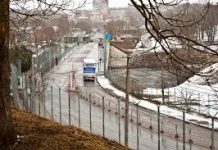
Austria will remain a member of the European Sky Shield Initiative and plans to increase its annual defense budget to 2% of its GDP under the incoming government, announced the newly formed coalition.
Earlier, there were indications that Austria might withdraw from the German-led Sky Shield air defense program if a far-right administration took power. However, coalition talks between the far-right Freedom Party and the conservative People’s Party collapsed, paving the way for a more moderate government. The parliamentary elections took place in September 2024.
Earlier last week, the incoming administration—comprising the conservative People’s Party, the Social Democrats, and the economic liberals – revealed that they had finalized a coalition agreement. This agreement outlines key policy objectives and ministerial appointments. The formation of this three-party alliance marks a historic first for Austria and is expected to maintain continuity with the previous government, which consisted of the conservatives and the Greens. This continuity extends to defense policy, where many of the coalition’s stances align with those of the prior administration. While the chancellor will continue to come from the People’s Party, it was still unclear at the time whether the defense ministry would also remain under its control.
Under the leadership of former Defense Minister Klaudia Tanner, Austria had opted to join the European Sky Shield Initiative, which currently includes 23 member states spanning from Scandinavia to Turkey. This military program aims to enhance coordination in acquiring and integrating air defense systems to counter potential threats from Russian missiles and drones.
The far-right Freedom Party, which has been criticized for its pro-Russian stance, had previously campaigned on a promise to withdraw from the Sky Shield, arguing that participation was incompatible with Austria’s constitutionally mandated policy of “perpetual neutrality.” Had they taken power, Austria was expected to become an obstacle to EU consensus and potentially reduce or withdraw diplomatic support for Ukraine.
While Austria, in line with its neutrality policy, does not supply weapons to Ukraine, it has provided diplomatic backing and non-lethal aid. The coalition that ultimately formed reaffirmed Austria’s commitment to supporting Ukraine and explicitly condemned Russia’s invasion in their official policy document.
Austria will also continue its efforts to modernize its military, following the “Construction Plan 2023+,” which aims to allocate approximately €17 billion ($17.7 billion) in additional defense spending by 2032. A notable change, however, is the explicit commitment to spending 2% of GDP on defense by that year. While this target mirrors NATO’s defense spending benchmark, Austria remains outside the alliance.
Furthermore, Vienna plans to establish a standby military force to ensure rapid response capabilities for unexpected threats. This force will consist of both professional soldiers and elements of the country’s militia. Austria maintains compulsory military service for all male citizens at the age of 18.
Another significant development is the government’s intention to phase out its current fleet of 15 Eurofighter Typhoons, which currently serve as the backbone of the Austrian Air Force. Officials have stated that a decision on this matter will be made soon, with Austria looking to acquire 36 new fighter jets. Both the American F-35 and the Swedish JAS-39 Gripen are reportedly being considered as potential replacements. Austria has a history of operating Saab aircraft, including the Saab 105, which was recently retired in favor of the Italian M-346, as well as past use of the Saab Gripen, Tunnan, B17A, and Safir models.




